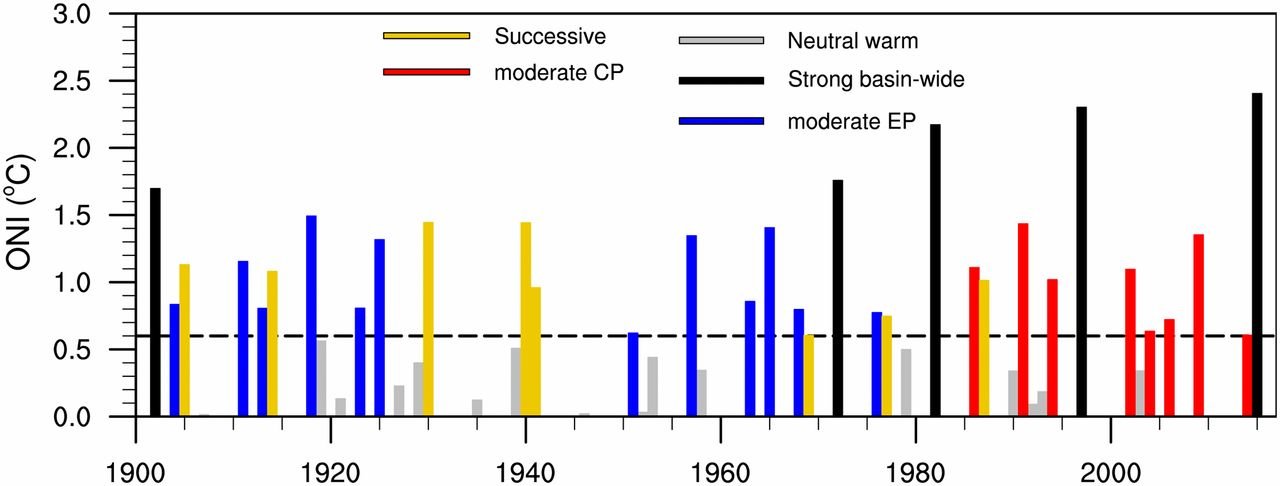No Evidence That Today’s El Niños Are Any Stronger than in the Past
/The current exceptionally strong El Niño has revived discussion of a question which comes up whenever the phenomenon recurs every two to seven years: are stronger El Niños caused by global warming? While recent El Niño events suggest that in fact they are, a look at the historical record shows that even stronger El Niños occurred in the distant past.
El Niño is the warm phase of ENSO (the El Niño – Southern Oscillation), a natural ocean cycle that causes drastic temperature fluctuations and other climatic effects in tropical regions of the Pacific. Its effect on atmospheric temperatures is illustrated in the figure below. Warm spikes such as those in 1997-98, 2009-10, 2014-16 and 2023 are due to El Niño; cool spikes like those in 1999-2001 and 2008-09 are due to the cooler La Niña phase.
A slightly different temperature record, of selected sea surface temperatures in the El Niño region of the Pacific, averaged yearly from 1901 to 2017, is shown in the next figure from a 2019 study.
Here the baseline is the mean sea surface temperature over the 1901-2017 interval, and the black dashed line at 0.6 degrees Celsius is defined by the study authors as the threshhold for an El Niño event. The different colors represent various regional types of El Niño; the gray bars mark warm years in which no El Niño developed.
This year’s gigantic spike in the tropospheric temperature to 0.93 degrees Celsius (1.6 degrees Fahrenheit) – a level that set alarm bells ringing – is clearly the strongest El Niño by far in the satellite record. Comparison of the above two figures shows that it is also the strongest since 1901. So it does indeed appear that El Niños are becoming stronger as the globe warms, especially since 1960.
Nevertheless, such a conclusion is ill-considered as there is evidence from an earlier study that strong El Niños have been plentiful in the earth’s past.
As I described in a previous post, a team of German paleontologists established a complete record of El Niño events going back 20,000 years, by examining marine sediment cores drilled off the coast of Peru. The cores contain an El Niño signature in the form of tiny, fine-grained stone fragments, washed into the sea by multiple Peruvian rivers following floods in the country caused by heavy El Niño rainfall.
The research team classified the flood signal as very strong when the concentration of stone fragments, known as lithics, was more than two standard deviations above the centennial mean. The frequency of these very strong events over the last 12,000 years is illustrated in the next figure; the black and gray bars show the frequency as the number of 500- and 1,000-year floods, respectively. Radiocarbon dating of the sediment cores was used to establish the timeline.
A more detailed record is presented in the following figure, showing the variation over 20,000 years of the sea surface temperature off Peru (top), the lithic concentration (bottom) and a proxy for lithic concentration (center). Sea surface temperatures were derived from chemical analysis of the marine sediment cores.
You can see that the lithic concentration and therefore El Niño strength were high around 2,000 and 10,000 years ago – approximately the same periods when the most devastating floods occurred. The figure also reveals the absence of strong El Niño activity from 5,500 to 7,500 years ago, a dry interval without any major Peruvian floods as reflected in the previous figure.
If you examine the lithic plots carefully, you can also see that the many strong El Niños approximately 2,000 and 10,000 years ago were several times stronger (note the logarithmic concentration scale) than current El Niños on the far left of the figure. Those two periods were warmer than today as well, being the Roman Warm Period and the Holocene Thermal Maximum, respectively.
So there is nothing remarkable about recent strong El Niños.
Despite this, the climate science community is still uncertain about the global warming question. The 2019 study described above found that since the 1970s, formation of El Niños has shifted from the eastern to the western Pacific, where ocean temperatures are higher. From this observation, the study authors concluded that future El Niños may intensify. However, they qualified their conclusion by stating that:
… the root causes of the observed background changes in the later part of the 20th century remain elusive … Natural variability may have added significant contributions to the recent warming.
Recently, an international team of 17 scientists has conducted a theoretical study of El Niños since 1901 using 43 climate models, most of which showed the same increase in El Niño strength since 1960 as the actual observations. But again, the researchers were unable to link this increase to global warming, declaring that:
Whether such changes are linked to anthropogenic warming, however, is largely unknown.
The researchers say that resolution of the question requires improved climate models and a better understanding of El Niño itself. Some climate models show El Niño becoming weaker in the future.
Next: Antarctica Sending Mixed Climate Messages








